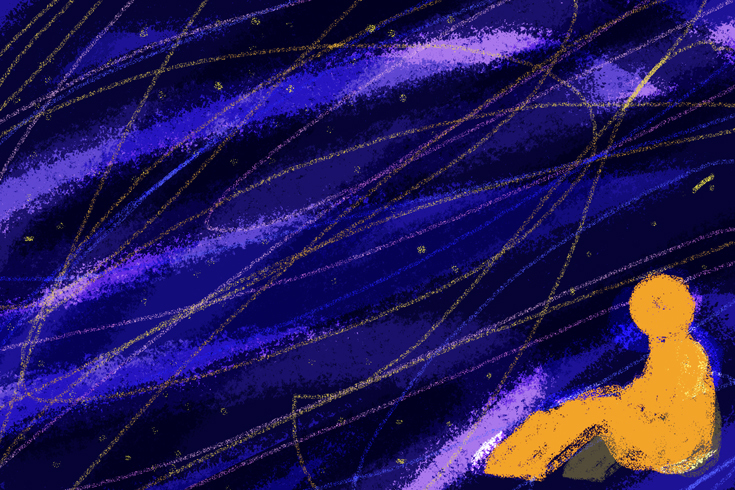Every year, when the days get shorter, the temperatures drop, and the snow starts to fall, Maya becomes exhausted. Her fatigue creeps in gradually: she feels it coming as early as September, and by November, she’s spending days in bed, unable to get up. Her productivity dwindles, making it a struggle to keep up with assignments and class readings. At her lowest points, she experiences long depressive episodes and suicidal ideation.
The winter blues are a relatively common affliction: according to the Centre for Addiction and Mental Health (CAMH), more than 15 percent of Canadians experience them as the days get shorter. Though not an official medical diagnosis, they refer to the feelings of sadness or stress associated with the winter months. As our environment gets colder and darker, and as the holidays bring on additional familial or financial pressures, it’s natural for people’s moods to worsen. But, rather than products of circumstance, Maya’s symptoms are part of a more serious mental health issue.
In 2018, Maya—who requested a pseudonym due to the stigma that still surrounds mental illness—was diagnosed with Seasonal Affective Disorder (SAD), a type of depression linked to seasonal changes and lack of sunlight. It’s less common than the winter blues are, affecting an estimated 2 to 5 percent of the population in Canada. It’s also more severe, its major symptom being an intense, persistent sadness that can last for weeks. Coupled with the bipolar disorder that Maya deals with year-round, SAD makes her winters especially difficult. Maya has found various ways to cope since her diagnosis: in addition to seeing a therapist, spending time out of the house with her friends and family are integral parts of getting through the winter. “Even if I’m in an incredibly low mood, being with other people definitely does help a lot,” she says.
As the surreal summer of 2020 drew to an end, winter was already at the back of Maya’s mind. COVID-19 and the restrictions that accompany it will present new challenges in the colder months—something we’ll all have to face. People are putting together their survival plans for getting through a pandemic winter: at sports stores, outdoor gear, like skis and skates, is flying off the shelves. Snowbirds are still opting to fly south despite the closed land border with the US. Restaurants are working to make patio dining possible despite the seasonal drop in temperature. The mental health toll of the pandemic has been well documented: financial loss, conflicting government messaging, and the threat of infection have all elevated the baseline level of stress that runs through our daily lives.
But, in a locked-down winter, psychologists are warning, our anxiety will only become heightened when the supports and strategies we’ve previously turned to for relief—the relative safety of outdoor gatherings, the sunlight that fills our homes in self-isolation—are no longer accessible.
In March, when the pandemic hit Canada with full force, we were immediately required to mourn the lives we were used to, not knowing when or if we would return to them. Regular tasks, like going to the grocery store, became sources of stress and guilt. Families were kept apart by travel restrictions and the fear of infection. For those who continued to work in-person service jobs, the emotional cost of their labour increased.
It’s unsurprising that these changes had a negative impact on mental health, with many Canadians reporting heightened levels of stress, a harder time dealing with preexisting psychological conditions, and a rise in substance abuse. An increase in virus-related stressors saw a corresponding decrease in people’s ability to access the necessary mental health care: according to the World Health Organization, the pandemic halted or disrupted 93 percent of mental health services across the globe. Long-underfunded systems were left in disrepair at a time when people needed them most, people facing obstacles like sudden bereavement, isolation, loss of income, and fear of infection. In addition, some survivors of COVID-19 needed and will continue to need better access to therapy after experiencing symptoms of depression and post-traumatic stress disorder.
The one bright spot was the arrival of spring. When lockdown restrictions loosened, spending time outside—where it’s easier to maintain space between people and COVID-19 has a lower risk of spreading—became a lifeline to normality. On sunny days, we could indulge in socially distanced versions of the same comforts we would any other summer: meet with friends and family for backyard beers, grab a bite on a patio, or relish in public green space. For brief moments, we could forget about how the pandemic had changed our lives.
There’s a laundry list of reasons why this winter poses new challenges: subzero temperatures will make it harder to gather outdoors, earlier sunsets will make for gloomier days in isolation, the arrival of a second wave means indoor amenities may have to close again, flu season presents additional public health difficulties, and people may have to deal with not seeing extended family for holiday visits.
The emotional stakes of these changes are high. After a year with so much unprecedented loss, what will it mean for our mental health to let go of still more comforts and traditions? Even if we’re able to meet with family or visit indoor businesses this winter, the risk assessment that accompanies indoor gatherings—Is everyone here wearing a mask? Is being here worth the possibility of getting sick? Of getting my family sick?—is taxing in itself. Our world is changing, once again, in ways beyond our control. This time, though, it’s possible to anticipate, and hopefully mitigate, the effects it may have on our mental health.
With the end of daylight saving time in most regions, it now gets dark in the early evening, the sun often setting before we’ve left our Zoom meetings or finished our assignments. The onset of the winter blues will make people feel more fatigued, and the pressures of work and school and the holidays may feel more intense—especially in the absence of regular seasonal joys like holiday parties and family visits. But, while this winter will be difficult for everyone, it may pose additional challenges for those who already suffer from mental illness.
“For people who have mental health difficulties, I think there is a risk that those difficulties could be exacerbated by the constant limitations on the kinds of supports that we’re used to having,” says Christine Purdon, a professor in the University of Waterloo’s department of psychology and the director of the department’s clinical training program. According to Purdon, it’s hard to make a blanket prediction about the impact this winter will have on mental wellness when people—and their situations—vary greatly. Factors like a person’s emotional support system, whether they’re working in person or remotely, and their financial situation will all shape how they deal with the strain of the coming months.
A lack of support is particularly significant. “The isolation that might come with the winter months is a very significant concern,” says David Gratzer, a physician and a psychiatrist at CAMH. Our locked-down world has created more reasons for us to stay solitary and sedentary. For many of us, our entire lives can now unfold virtually and indoors. This means that, apart from the occasional grocery trip or patio beer, there isn’t much reason to leave the house—when the cold makes venturing out less appealing, our at-home lives might feel even more isolating than they do now.
Winter’s effects on mental health are especially pressing for those, like Maya, whose depression already has a seasonal component. For them, it’s especially important to come up with a plan for the colder months, revisiting and building on strategies they found useful in the past. What makes a good coping strategy for seasonal depression varies depending on the person: for Maya, it’s seeing a doctor and spending time with her family. For Natasha O’Neill, an undergraduate student at Wilfrid Laurier University’s Brantford campus, spending time outside is the most important part of dealing with her low moods and unshakable exhaustion.
Though she’s never been formally diagnosed with SAD, O’Neill has struggled with her mental health every winter since starting university, in 2017. O’Neill moved from the country, where she had spent most of her time outside even in the winter, and living in the city took a toll on her. When her symptoms reached their height, she went to her school’s mental wellness centre, where a nurse recommended that, whenever possible, she should spend more time outside. For O’Neill, this has become a form of comfort: each winter, she prioritizes activities like downhill skiing, outdoor skating, and taking walks with friends. She also uses a light-therapy box, a device that replicates the effect of sunlight for people with seasonal depression.
As we face up to a COVID-19 winter, Purdon’s biggest piece of advice is one that we can probably use year-round: talk to your friends and loved ones about topics other than the pandemic. “It’s easy to fall into real doom-and-gloom kinds of conversations with people and just debrief with each other constantly about how challenging things are, how difficult and how scary it is,” she says. But, if we constantly talk about the stress we’re feeling, we’re bound to burn ourselves out.
There’s no blanket solution for the challenges of the coming months. In the midst of what CAMH calls an “unprecedented global health, social, and economic crisis,” it’s easy to suggest buying a light-therapy box or spending more time outside. It’s harder to actually do those things while coping with worsening symptoms. “If you feel like you’re overwhelmed, I think it’s important to talk to a health care professional,” Gratzer says. “Maybe it isn’t a major depressive disorder. That being said, it’s still important to sort these things out early.”






